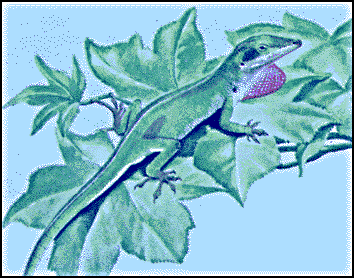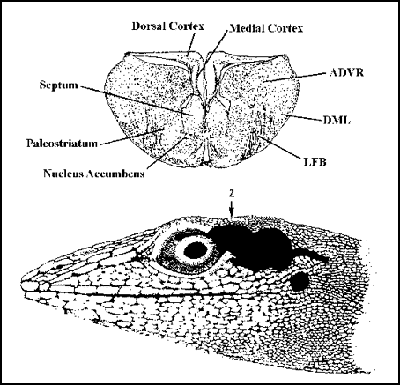
Anolis carolinensis

Anolis carolinensis
The green anole (Anolis carolinensis), also erroneously called the American Chameleon (it is not closely related to true chameleons), is a small insect eating lizard (about 12 cm) that is common in the Southeastern United States. It is usually green, but can change its skin color from bright green to dark brown. Male anoles are territorial and establish social dominance systems. The anole shown here has his dewlap (red flap of skin) extended.
Tree of Life: Iguaninae
Anolis carolinensis produces a complex, but stereotyped set of behaviors in various social contexts including aggression, submission, and courtship. Adult male anoles are territorial and establish dominance through a set of ritualized displays and fighting. These behaviors can be grouped roughly into Assertion displays and Challenge displays. Assertion displays, which sometimes occur in the absence of another male include head bobbing, typically accentuated by pushup-like extensions of the forelimbs, and dewlap extension (extension of a large flap of skin under the throat). Challenge displays are only elicited by the presence of another male and typically lead to territorial contention and fighting. They begin with assertion displays but include throat extensions (different from dewlap extension), sagittal expansion (dorsal-ventral enlargement of body profile), lateral orientation (turning so the side profile of the body is displayed to opponent), protrusion of crests along the neck and back, and formation of an darkened area behind the eye called an eyespot. If neither combatant retreats, they will fight by biting and interlocking their jaws. Thereafter, the loser will typically produce submissive head- bobbing displays and occupy lower, less desirable perches.

Coronal section of the anole brain showing the paleostriatum and related
structures (top), taken at the level indicated by Z. Diagram of position
of brain (bottom).
In the lizard brain, the paleostriatum lies below the dorsal medullary lamina. It can be subdivided into medial and lateral regions. The medial region consists of the nucleus accumbens, while the lateral region may give rise to the lateral forebrain bundle, suggesting it corresponds to the mammalian globus pallidus. In a 1977 study, Greenberg performed electrolytic lesions of the paleostriatum and examined the effects on territorial displays. After surgery, lizards were tested by allowing experimental animals to view other males in adjacent cages and by introduction of new males into the experimental animals' home terrarium. Interestingly, lesions disrupted behaviors associated with challenge displays, but not assertion displays or other more general behaviors (eg. prey tracking, overall activity). This is consistent with a theory from primate research that the striatal complex, possibly a portion related to the reptilian paleostriatum, is involved in species-typical display behavior.
In addition to the paleostriatal role in display behavior, several neurotransmitter systems have been implicated in various aspects of reptile social interaction, including serotonin (5-HT), dopamine, and epinephrine. For example, the production of the eyespot color change has been found to be epinephrine-induced and combatants that produce the eyespot earlier are more likely to win fights. There is some evidence that 5-HT is associated with acquisition of dominant status in lizards. However, Summers (1995) found increased 5-hydroxytryptophan (5-HTP; a 5-HT precursor), decreased 5-HT and 5-hydroxyindoleacetic acid (5-HTIAA; a 5-HT metabolite) were found in lizards that lost a fight. The pattern of increased precursor and decreased neurotransmitter, and increased metabolite seen one hour after an aggressive encounter suggests an activated system. Thus, serotonin systems in the diencephalon, non-optic lobe midbrain, and hindbrain are activated in subordinate male lizards, possibly reflecting a serotonergic role in suppressing aggressive behaviors and supporting submissive posturing.
SELECTED REFERENCES
Early Classics:
Greenberg, B. and Noble, G. K. (1944). Social Behavior of the American Chameleon (Anolis Carolinensis). Physiol. Zool. 17(4):392-439.
Greenberg, N. (1977). A Neurethological Study of Display Behaviors in the Lizard Anolis Carolinensis (Reptilia, Lacertilia, Iguanadae). Amer. Zool. 17:191-201.
Jenssen, T. A. (1970). Display Repertoire Analysis of Anolis Nebulosus (Sauria Iguanadae). J. Herptol. 4:1-38.
Reviews:
Jenssen, T. A. (1977). Evolution of Anoline Lizard Display Behavior. Amer. Zool. 17:205-215.
Greenberg, N. (1977). Ethological Considerations in Experimental Study of Lizard Behavior. In N. Greenberg and P. MacLean (eds.), Behavior and Neurology of Lizards: An Interdisciplinary Conference. N.I.M.H., Rockville, Md.
Some Recent Advances:
Summers, C. H. and Greenberg, N. (1994). Somatic Correlates of Adrenergic Activity During Aggression in the Lizard Anolis Carolinensis. Hormones Behav. 28:29-40.
Summers, C. H. and Greenberg, N. (1995). Activation of Central Biogenic Amines Following Aggressive Interaction in Male Lizards, Anolis Carolinensis. Brain Behav. Evol. 45:339-349.
Related Topics:
MacLean, P. D. (1975). Role of Pallidal Projections in Species-Typical Display Behavior of Squirrel Monkeys. Trans. Amer. Neurol. Assoc. 100:25-28.
This page prepared by:
Dave Smith, Dec. 96
